Friday, June 10, 2005
In search of WW II: the Ardennes Offensive
In December 1944, Hitler ordered a surprise offensive through the Ardennes forest against outnumbered American forces in what had been a quiet sector of the front. The resulting “Battle of the Bulge,” was the largest single land battle in the history of the U.S. Army.
The terrain on which this battle, the Ardennes forest from the German border, across Luxembourg, to the Meuse river in Belgium, is extremely beautiful.
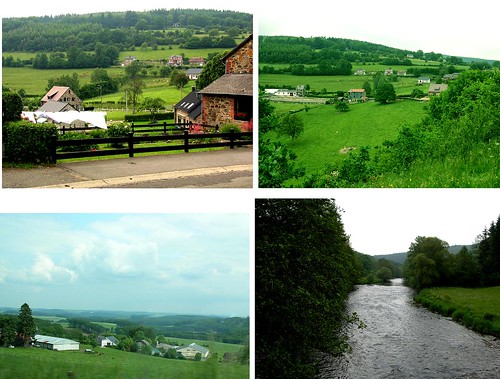
Belgium and Luxembourg landscapes. Lower right: the Ambleve River.
The most famous episode of the Battle of the Bulge was the fight for Bastogne, a critical transportation junction in which seven roads come together. The 101st U.S. Airborne Division, together with elements of a few other army units, held the town despite being undersupplied and entirely surrounded by the German army for five days.
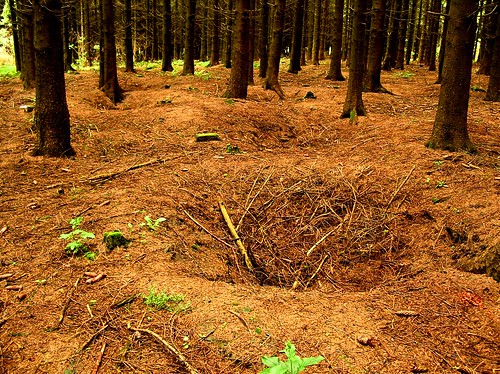
In this eerily quiet pine woods you can still see the remnants of foxholes where the 502nd Parachute Infantry Regiment, 101st Airborne Division, dug in on the perimeter around Bastogne.
After visiting Bastogne, we drove through the picturesque Ambleve Valley, where Kampfgruppe Pieper, a battalion of Tiger tanks spearheading the German advance, was repeatedly foiled in its effort to seize one of the severals bridges across the Ambleve River and were eventually stopped when they ran out of fuel.
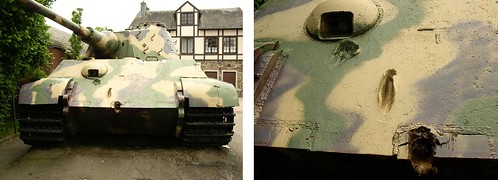
A rare surviving Tiger tank, the largest armored vehicle deployed in WWII. Note how these hits on the Tiger's frontal armor (probably from bazooka rounds) made harmless gouges that look like scooping out clay with your finger.

Our rental car superimposed on the Tiger for scale. (No, we didn't drive up the tank's rear end.) This is a mid-sized Mercedes, by the way.

History repeats itself? Our rented Mercedes is unwilling or unable to cross this bridge over the Ambleve. I can't imagine the behemoth Tiger fitting onto this bridge, which probably didn't exist in 1944 anyhow.
Here's the Ambleve River, where it runs alongside the village of Coo. Note the "Friture," or french fry shop, at right:
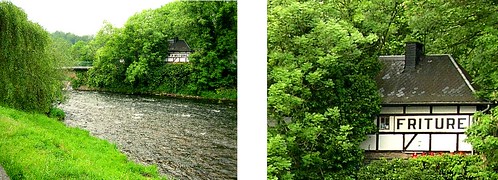
You know, it's the Belgians, more than the French, who make a big deal of pommes frites (fried potatoes), and Belgians are in fact sometimes referred to as "pommes frites" (like Germans are called "krauts"). We saw fry shops all over Belgium.
The fry thing spills over into Luxembourg. Below: dinner in Luxembourg. That's a huge side of fries (with wine) on that table behind us. Look, it's as big as the bread basket!
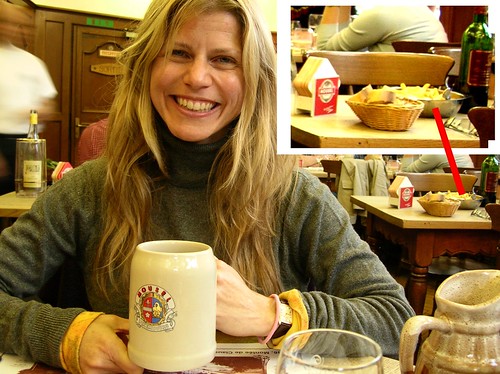
The dinner in Luxembourg City was a story deserving a post unto itself. Stay tuned.
**
The terrain on which this battle, the Ardennes forest from the German border, across Luxembourg, to the Meuse river in Belgium, is extremely beautiful.

Belgium and Luxembourg landscapes. Lower right: the Ambleve River.
The most famous episode of the Battle of the Bulge was the fight for Bastogne, a critical transportation junction in which seven roads come together. The 101st U.S. Airborne Division, together with elements of a few other army units, held the town despite being undersupplied and entirely surrounded by the German army for five days.

In this eerily quiet pine woods you can still see the remnants of foxholes where the 502nd Parachute Infantry Regiment, 101st Airborne Division, dug in on the perimeter around Bastogne.
After visiting Bastogne, we drove through the picturesque Ambleve Valley, where Kampfgruppe Pieper, a battalion of Tiger tanks spearheading the German advance, was repeatedly foiled in its effort to seize one of the severals bridges across the Ambleve River and were eventually stopped when they ran out of fuel.

A rare surviving Tiger tank, the largest armored vehicle deployed in WWII. Note how these hits on the Tiger's frontal armor (probably from bazooka rounds) made harmless gouges that look like scooping out clay with your finger.

Our rental car superimposed on the Tiger for scale. (No, we didn't drive up the tank's rear end.) This is a mid-sized Mercedes, by the way.

History repeats itself? Our rented Mercedes is unwilling or unable to cross this bridge over the Ambleve. I can't imagine the behemoth Tiger fitting onto this bridge, which probably didn't exist in 1944 anyhow.
Here's the Ambleve River, where it runs alongside the village of Coo. Note the "Friture," or french fry shop, at right:

You know, it's the Belgians, more than the French, who make a big deal of pommes frites (fried potatoes), and Belgians are in fact sometimes referred to as "pommes frites" (like Germans are called "krauts"). We saw fry shops all over Belgium.
The fry thing spills over into Luxembourg. Below: dinner in Luxembourg. That's a huge side of fries (with wine) on that table behind us. Look, it's as big as the bread basket!

The dinner in Luxembourg City was a story deserving a post unto itself. Stay tuned.
**
Subscribe to Comments [Atom]
